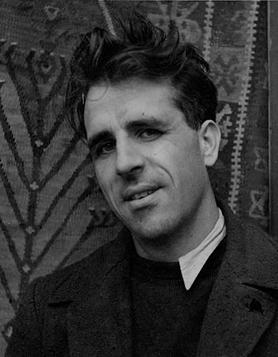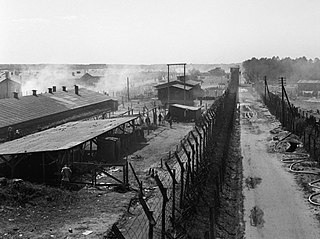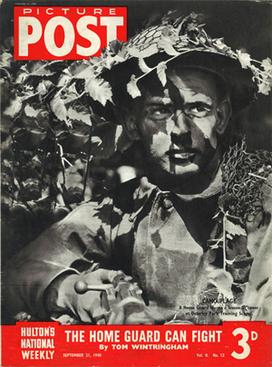
Mervyn Laurence Peake was an English writer, artist, poet, and illustrator. He is best known for what are usually referred to as the Gormenghast books. The four works were part of what Peake conceived as a lengthy cycle, the completion of which was prevented by his death. They are sometimes compared to the work of his older contemporary J. R. R. Tolkien, but Peake's surreal fiction was influenced by his early love for Charles Dickens and Robert Louis Stevenson rather than Tolkien's studies of mythology and philology.

Bergen-Belsen, or Belsen, was a Nazi concentration camp in what is today Lower Saxony in northern Germany, southwest of the town of Bergen near Celle. Originally established as a prisoner of war camp, in 1943, parts of it became a concentration camp. Initially this was an "exchange camp", where Jewish hostages were held with the intention of exchanging them for German prisoners of war held overseas. The camp was later expanded to hold Jews from other concentration camps.

Picture Post was a photojournalistic magazine published in the United Kingdom from 1938 to 1957. It is considered a pioneering example of photojournalism and was an immediate success, selling 1,000,000 copies a week after only two months. It has been called the UK's equivalent of Life magazine.

Bergen-Belsen displaced persons camp was a displaced persons (DP) camp for refugees after World War II, in Lower Saxony in northwestern Germany, southwest of the town of Bergen near Celle. It was in operation from the summer of 1945 until September 1950. For a time, Belsen DP camp was the largest Jewish DP camp in Germany and the only one in the British occupation zone with an exclusively Jewish population. The camp was under British authority and overseen by the United Nations Relief and Rehabilitation Administration (UNRRA) with camp directors that included Simon Bloomberg. Today, the camp is a Bundeswehr barracks, having been a British Army base until 2015.
Events from the year 1945 in art.
Abram Games was a British graphic designer. The style of his work – refined but vigorous compared to the work of contemporaries – has earned him a place in the pantheon of the best of 20th-century graphic designers. In acknowledging his power as a propagandist, he claimed, "I wind the spring and the public, in looking at the poster, will have that spring released in its mind." Because of the length of his career – over six decades – his work is essentially a record of the era's social history. Some of Britain's most iconic images include those by Games. An example is the "Join the ATS" poster of 1941, nicknamed the "blonde bombshell" recruitment poster. His work is recognised for its "striking colour, bold graphic ideas, and beautifully integrated typography".

Doris Clare Zinkeisen was a Scottish theatrical stage and costume designer, painter, commercial artist, and writer. She was best known for her work in theatrical design.
Mary Merlin Kessell was a British figurative painter, illustrator, designer and war artist. Born in London, she studied at the Clapham School of Art, then later at the Central School of Arts and Crafts. At the end of the Second World War, she was commissioned to work in Germany as an official British war artist; one of only three women selected. She spent six weeks in Germany, travelling to the recently liberated Bergen-Belsen concentration camp as well as other major cities including Berlin. She produced charcoal drawings of refugees, primarily of women and children which she subsequently sold to the War Artists Advisory Committee. After the war Kessell collaborated with the Needlework Development Scheme, NDS, to produce experimental designs for machine and hand embroidery as well as working for Shell as a designer. She later returned to the Central School to teach at the School of Silversmithing and Jewellery alongside the painter Richard Hamilton.

Leslie James Cole was a British artist and teacher. He served as a war artist from 1942 to 1946 during which time he recorded events in several theatres of war and also the aftermath of the liberation of the Bergen-Belsen concentration camp.
Mona Mary Moore, also known as Mona Bentin and later as Deborah Bentin, was a British painter and illustrator, best known for her work during World War Two for both the Recording Britain project and for the War Artists' Advisory Committee. Her work also appeared regularly in a number of magazines including Good Housekeeping, the Radio Times and The Listener.

Alan Moore was an Australian war artist during World War II. He is best known for his images of the Bergen-Belsen concentration camp, and the Australian War Memorial holds many of his works.
Charles Alfred Mozley was a British artist who was also a teacher. He was a prolific book illustrator and designer of book covers, posters and prints.
Thomas Cantrell Dugdale was a British artist. He was a member of the Royal Academy, was a renowned portrait painter and served as a war artist in both World War One and World War Two.
Eric Wilfred Taylor was a British artist and teacher. Although he had a long career encompassing painting, printmaking and the production of sculptures, murals, and ceramics, he is now perhaps best known for the works he created during the Second World War and in particular the paintings he produced when he was among the British troops that liberated the Bergen-Belsen concentration camp.
John Mansbridge (1901–1981) was a British artist. He was an official war artist during World War II and Head of Fine Art at Goldsmiths College in London.

In early April 1945, at the request of the British Army, the British Red Cross and the War Office called for 100 volunteer medical students from nine London teaching hospitals to assist in feeding starving Dutch children who had been liberated from German occupation by advancing Allied forces. However, in the meantime, British troops had liberated Bergen-Belsen concentration camp and the students were diverted there on the day they were due to travel to the Netherlands. The students had previously spent most of the Second World War at school and in medical training.

Michael John Hargrave was a British general practitioner in Wootton Bassett, Wiltshire, who in 1945 assisted British Army occupation forces at the recently-liberated Bergen-Belsen concentration camp when he volunteered as a medical student from Westminster Hospital at the age of 21.

Dennis Henry Forsdick, was a British physician at the Friarsgate Medical Centre. In 1945, while studying medicine at Guy's Hospital, he assisted at Bergen-Belsen concentration camp as a voluntary medical student.

Irene Haschke was a German SS camp guard within the Nazi concentration camp system during World War II, notably, at the Bergen-Belsen camp in what is today Lower Saxony in northern Germany, southwest of the town of Bergen near Celle. She was born in Friedeberg, Neumark in what is now Poland.

Bergen-Belsen 1945: A Medical Student's Journal is Michael Hargrave's diary of his experiences providing medical assistance to the former inmates of Bergen-Belsen concentration camp between 28 April and 28 May 1945. It was written for his mother after he volunteered for the work while he was a student at Westminster Hospital Medical School in London. It is a typescript of the diary, which was originally hand-written, and begins with a foreword by the head of research at the Imperial War Museum and brief background notes by Hargrave's son David. Centre pages include photographs of the London medical students and the state of the camp, including the "human laundry".












